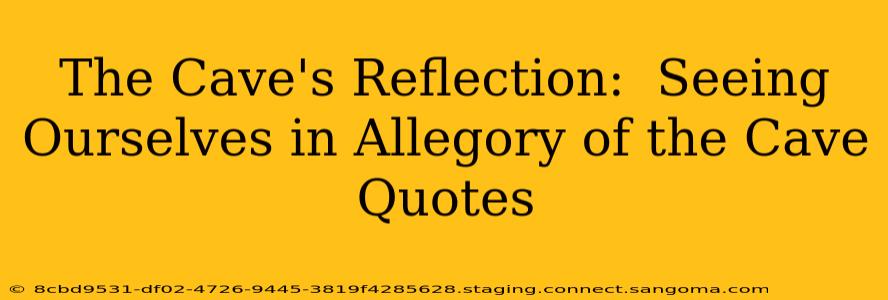Plato's Allegory of the Cave, found in The Republic, is more than just a philosophical puzzle; it's a powerful reflection on our perceptions of reality, knowledge, and the journey towards enlightenment. The story's enduring relevance lies in its ability to resonate with our own experiences, prompting introspection on how we interpret the world around us. This exploration delves into key quotes from the allegory and their profound implications for understanding ourselves and our place in society.
What is the main point of Plato's Allegory of the Cave?
The central message of Plato's Allegory of the Cave revolves around the nature of reality and the pursuit of knowledge. Plato argues that most people live in a state of ignorance, mistaking shadows and illusions for true reality. The "cave" represents this limited perception, where individuals are chained and only see the flickering images projected on the cave wall. The escape from the cave symbolizes the arduous process of philosophical inquiry and the ascent towards true understanding. Ultimately, the allegory emphasizes the importance of critical thinking, questioning assumptions, and seeking knowledge beyond the surface level. The escaped prisoner's return to the cave highlights the challenges of enlightening others and the resistance often encountered when challenging established beliefs.
What are the shadows in Plato's Allegory of the Cave?
The shadows in Plato's Allegory of the Cave represent the imperfect and illusory world of appearances. These shadows are not real objects themselves, but merely reflections of objects cast by a fire. They stand as a metaphor for our everyday perceptions, often based on incomplete or distorted information. In our lives, these "shadows" could be anything from superficial societal beliefs and media portrayals to biased interpretations of events, all of which prevent us from grasping a deeper, more accurate understanding of reality. They're the things we take as truth without critical examination.
What does the sun represent in Plato's Allegory of the Cave?
The sun in Plato's allegory is a powerful symbol of the Form of the Good. This isn't the physical sun, but rather the ultimate source of truth, knowledge, and understanding. Just as the physical sun illuminates the world, allowing us to see physical objects clearly, the Form of the Good illuminates the world of Forms, allowing us to understand true reality. It represents the ultimate source of all goodness, truth, and beauty. Reaching the sun signifies attaining enlightenment and achieving a complete understanding of the true nature of reality.
What does the escaped prisoner represent in Plato's Allegory of the Cave?
The escaped prisoner embodies the philosopher who, through reason and critical thinking, breaks free from the limitations of his limited perception. His journey out of the cave symbolizes the intellectual journey of philosophical inquiry and the challenging process of self-discovery. The experience of blinding sunlight represents the initial shock of encountering true knowledge, which can be overwhelming at first. The prisoner's eventual adaptation to the sunlight symbolizes the gradual comprehension and acceptance of a higher level of truth.
What is the significance of the prisoner's return to the cave?
The escaped prisoner's return to the cave is arguably the most poignant part of the allegory. It highlights the difficulties involved in sharing enlightenment with those who remain trapped in ignorance. The other prisoners, accustomed to their limited world, initially reject and even ridicule the prisoner's claims of a higher reality. This underscores the inherent resistance to change and the difficulty of challenging established beliefs, even when presented with compelling evidence. It's a stark reminder of the societal challenges faced by those who try to introduce new ideas or perspectives.
What does the allegory say about education?
Plato’s Allegory of the Cave offers a powerful metaphor for education, arguing that true education is not merely about accumulating information but rather about turning towards the "light" – towards reason, critical thinking, and the pursuit of truth. The escape from the cave represents the process of intellectual growth and the gradual acquisition of knowledge that leads to true understanding. The allegory emphasizes the importance of questioning assumptions, challenging societal norms, and developing the capacity for independent thought. It also emphasizes the teacher's crucial role in guiding students on this journey of intellectual liberation.
This exploration provides a more in-depth understanding of Plato's allegory, connecting the symbolic elements to their broader philosophical implications. By examining the various interpretations of the allegory, we can gain valuable insights into our own understanding of reality and the importance of continuous intellectual growth.

